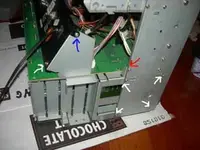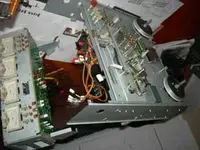maybe you could just check from the tape heads, but if you have to clean them well or resolder, I guess it'd be pretty hard to do it all attached up like that. when I was checking mine, I wanted to be able to check each connection individually to see exactly which was not connecting - if you open that all up, you can check each one individually. if i remember right, there were something like 4 solder joints between the top of the motherboard (where the cables came from the tape head) to the underside (where the cables lead to the channel boards) these are all in a very small area on the board, but I had to check them all individually before they worked. and if you havn't cleaned them all up good with a toothbrush and deoxit, you'll want to do that - I don't know that you could get away with just spraying some deoxit on it. I cleaned mine with isopropyl and a toothbrush - it was pretty dirty though.
I've included some pictures from when I did this that might help. it seems really intimidating at first to take it all apart this much, but these machines seem made to be taken apart - lots of times I've tried in vain to unscrew something that was just too tight and would strip my screwdriver before it could come loose, just to find that I didn't need to unscrew that one and it was perhaps looked in on purpose - the ones you want to take out are usually a bit easier...

- one thing I remember is that there is one bit that you might think you have to unscrew, but it actually slides back to release the lower portion (more on this below w/ picture). all the plastic connections are color coded so it would be difficult to put it back together wrong - but do take a good look at it before you start unplugging things and take a picture beforehand if you want to be safe.

so, the white arrows show you where you need to unscrew. you will need to detach that black plate where all the rca ins & outs go - so that screw with the white arrow there, and the blue arrow, I think you can get away with just unscrewing one side because the other side will slip off. you do NOT need to unscrew the red arrow screw, this is where you slide it into place, so it just needs to be pushed back so it can slide out. (this was the screw I couldn't get unscrewed then realized I didn't need to...) however at this point, on my machine I had to slide this little metal piece forward with a screwdriver with a moderate force so that it could keep from clasping and slip through the hole that it was meant to slip from (great terminology here!

)
you've got to take all those plastic connections off at the motherboard - they are connected both to that black panel and to the rest of unit etc. again, it seems intimidating, but its all color coded and after you do it once, you wonder what your fuss was about. take a picture of it all connected to be safe.
here are some pictures of my 34 with bottom disassembled:


I hope this helps!
I had a fun time taking mine apart after all was said & done (and fixed!)
Its nice to get to know these machines a little on the inside...




 - one thing I remember is that there is one bit that you might think you have to unscrew, but it actually slides back to release the lower portion (more on this below w/ picture). all the plastic connections are color coded so it would be difficult to put it back together wrong - but do take a good look at it before you start unplugging things and take a picture beforehand if you want to be safe.
- one thing I remember is that there is one bit that you might think you have to unscrew, but it actually slides back to release the lower portion (more on this below w/ picture). all the plastic connections are color coded so it would be difficult to put it back together wrong - but do take a good look at it before you start unplugging things and take a picture beforehand if you want to be safe. 

